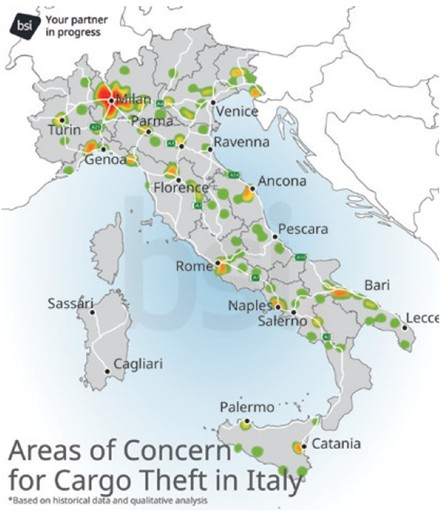Freight crime has surged dramatically in Italy with incidents of theft quadrupling in the last two years, according to the latest analysis from international freight insurer, TT Club, resilience and security network, Transported Asset Protection Association, and business improvement consultants BSI SCREEN.
Due to its geographic location near the centre of Europe and the Mediterranean Sea, Italian ports are obvious entry points for many supply chains leading into Europe. Lombardy, in particular the area surrounding Milan, typically experiences the highest rates of cargo theft in Italy, the new report highlights.
Like many countries, Italy is seeing a rise in strategically planned cargo theft, with criminal groups employing ever more sophisticated means to infiltrate the legitimate supply chain.
The report highlights however that Italy is particularly attractive to thieves due to its well-known market of luxury and designer goods.
Indeed, clothing, apparel and pharmaceuticals are noted as the most targeted commodities.
The report highlights more than 400% increase in the frequency of insurance claims since 2021, nearly a third of claims arising from theft from vehicles parked insecurely or at the roadside, the region of Lombardy as the region with the highest rates of cargo theft, significant lack of secure parking with only one space per 289 trucks, notable increase in cargo theft from rail and emerging trend of drone usage by criminals to investigate possible target sites.

TT Club, in collaboration with BSI SCREEN and TAPA EMEA, underscores the increasing threat to the Italian supply chain pose chiefly by organised crime and its sophisticated theft methods.
The extensive report shines a spotlight on the dynamic and evolving nature of freight crime in Italy, and the steps necessary to combat the threat.
“Italy is not alone in experiencing concerning increases in cargo theft,” comments Josh Finch, logistics risk manager at TT Club. “We are seeing the same trends across the board, with major highways and industrial hubs becoming key targets for criminals. The statistics clearly highlight the key issue: cargo at rest, unsecurely parked, parked on the roadside, around these main intersections, is most at risk.”
“A lack of access to safe and secure parking is a global problem, of which Italy is an acute example,” comments Panayiotis Laimos, standards and training support, TAPA EMEA. “At TAPA, we create standards that focus on all risks within an end-to-end supply chain risk mitigation model. We must focus on a ‘goods at rest are goods at risk’ strategy and combine people and technology on the best way.”
The co-authors outline the increasingly sophisticated means used by criminals to access cargo, specifically the emerging use of drones as a reconnaissance tool.
“Many modern drones may operate for 30+ minutes, more than enough time to stake out a site, noting its vulnerabilities, the location of security cameras and guard stations. They are quiet, have excellent visibility and are often difficult to spot; we have even seen cases of drones entering warehouse facilities unobserved through open bay doors. In this way, thieves are increasingly able to build a profile of the goods that are stored and exactly where to find them,” explains Finch.



